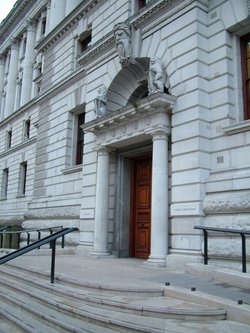HM Treasury
|
|
HM Treasury (Her/His Majesty's Treasury) is the United Kingdom government department responsible for and putting into effect the UK Government's financial and economic policy. The Treasury's stated aim is to raise the rate of sustainable growth, and achieve rising prosperity, through creating economic and employment opportunities for all.
| Contents |
History
The English Treasury seems to have come into existence around 1126, in the reign of Henry I. The treasury emerged out of the royal household, and served as the location where the king kept his treasures. The head of the treasury was called the Lord Treasurer. Starting in Tudor times, the Lord Treasurer became one of the chief officers of state, and competed with the Lord Chancellor for the principal place.
In 1667 Charles II of England was responsible for appointing George Downing, (the builder of Downing Street,) to radically reform the Treasury and the collection of taxes.
Beginning in the 17th century, the Treasury was frequently entrusted to a commission, rather than to a single individual, and after 1714, it was always in commission. The commissioners were referred to as Lords of the Treasury, and given a number based on seniority. Eventually, the First Lord of the Treasury came to be seen as the natural head of any government, and from Robert Walpole on, began to be known, unofficially, as the prime minister. Before 1827, the First Lord of the Treasury, when a commoner, also held the office of Chancellor of the Exchequer, while if the First Lord was a peer, the Second Lord would usually serve as Chancellor. Since 1827, the Chancellor of the Exchequer has always been Second Lord of the Treasury.
Whips
Some of the Government Whips are also associated in name with the Treasury: the Chief Whip is nominally Parliamentary Secretary to the Treasury and traditionally had an office in 12 Downing Street. Some of the other Whips are nominally a Lord Commissioner of HM Treasury though these are all members of the House of Commons. This led to the Government frontbench in the Commons being known as the Treasury Bench. However, since the Whips no longer have any effective ministerial role in the Treasury, they are usually not listed as Treasury ministers.
Ministers of HM Treasury
as of 9 September, 2004
- Prime Minister and First Lord - The Rt Hon. Tony Blair MP
- Chancellor of the Exchequer and Second Lord - The Rt Hon. Gordon Brown MP
- Chief Secretary to the Treasury - The Rt Hon. Paul Boateng MP
- Paymaster General - The Rt Hon. Dawn Primarolo MP
- Financial Secretary to the Treasury - Stephen Timms MP
- Economic Secretary to the Treasury - John Healey MP
Permanent Secretaries of HM Treasury
The position of Permanent Secretary of HM Treasury is generally regarded as the second most prestigious in the British Civil Service; the last two incumbents have gone on to be Cabinet Secretary, the only post out-ranking it.
Agencies of HM Treasury
- UK Debt Management Office headed by the Financial Secretary
- National Savings and Investments headed by the Financial Secretary
- Office for National Statistics Financial Secretary
- OGCBuying.Solutions headed by the Chief Secretary to the Treasury
- The Royal Mint headed by the Financial Secretary
- Valuation Office headed by the Paymaster General
See also
- Lord High Treasurer
- List of Lord Treasurers
- First Lord of the Treasury
- List of Commissioners of the Treasury
- UK topics

